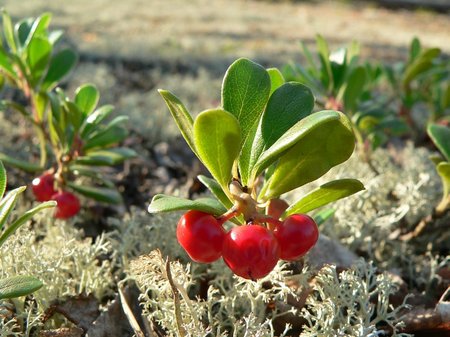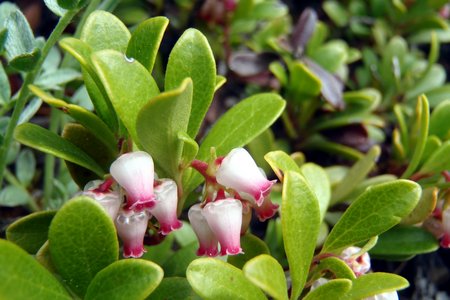The bearberry (Arctostaphylos uva-ursi) is an attractive evergreen shrub of great importance in herbal medicine. It is a very useful plant. The bearberry was used for tobacco by the Native Americans, who also utilized the mealy red berries for food and beverages. The small, leathery leaves yield a medicinal astringent and a dye. It is used to treat bladder and kidney infections but, as with all medicinal herbs, on no account should any part of the plant be used at home. The roots can be made into a tea that can treat a constant cough or slow down menstrual bleeding.
It needs acid soil to flourish and can be grown in a container with conifers or in the garden, used as a ground cover plant in acid soil. Being evergreen, it retains the interest of the leaves throughout the winter.

There are no known varieties of bearberry available. The bearberry is commonly found in dry, non-nutrient soils such as sand, soils on rock outcrops and shallow soils. This plant ranges from northern California to Alaska, east from Oregon and Washington to the mountains of west Montana, and from there, south to New Mexico.

Bearberry can be propagated from seeds, softwood cuttings or pre-rooted stem cuttings. It is difficult to root this plant from bare cuttings in the greenhouse. Scarified seed sown in early summer will improve germination the following spring, but this technique is not as reliable as cuttings. Softwood cuttings should be harvested in late summer, and rooted stem cuttings are most successful when harvested during the dormant season.

The bearberry has a stem that rises 2-8″ off the ground and is covered in a thick bark and fine silky hairs. On the stem are many oval-shaped, leathery leaves (dark green, shiny, spoon-shaped leaves carried on long trailing shoots). The flowers have five petals and are pale pink or white. The petals are curled around the narrow center. They bloom anywhere between March and June. The fruit is a red berry 3/8″ in diameter. The bearberry gets its name because bears like to feast on these berries.

This shrub species requires very little maintenance once it has been established. Annual spring applications of 10-10-10 will increase the growth rate of bearberry, but will also increase weed growth. Weed growth must be controlled to sustain healthy stands of bearberry.

